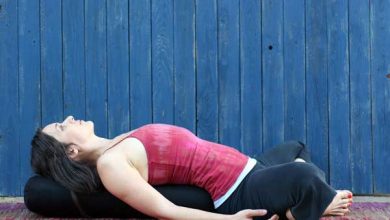How To Do The Plank Pose And What Are Its Benefits : Vasisthasana
Vasisthasana (VAH-shees-THAH-suh-nuh) challenges your ability to stay calm and focused. Its name comes from the Sanskrit word “Vasistha,” which literally means, “most excellent” or “best.” The word implies the spiritual contentment that those on the yogic path can attain. Many great yoga sages have been named “Vasistha.” Thus, the pose is also sometimes referred to as “Sage Pose.”
What You Should Know Before You Do The Asana
Please avoid this pose if you have an arm, shoulder, or wrist injury. Vasisthasana requires a lot of strength to be performed correctly. It is very easy to injure yourself if you move into it too soon. If you do not yet have the strength to do the pose in proper alignment, practice a modified version until you can support your full body weight correctly. Always work within your own range of limits and abilities. If you have any medical concerns, talk with your doctor before practicing yoga.

How To Do The Vasisthasana : Step-by-Step Instructions
1. Start in Adho Mukha Svanasana. Then inhale and draw your torso forward until the arms are perpendicular to the floor and the shoulders directly over the wrists, torso parallel to the floor.
2. Press your outer arms inward and firm the bases of your index fingers into the floor.
3. Firm your shoulder blades against your back, then spread them away from the spine. Also spread your collarbones away from the sternum.
4. Press your front thighs up toward the ceiling, but resist your tailbone toward the floor as you lengthen it toward the heels.
5. Lift the base of the skull away from the back of the neck and look straight down at the floor, keeping the throat and eyes soft.
6. Plank Pose is one of the positions in the traditional Sun Salutation sequence. You can also perform this pose by itself and stay anywhere from 30 seconds to 1 minute.
Tips
Vasisthasana can build arm and core strength quickly. However, it’s vital to ensure you are performing the pose with correct alignment; otherwise, it’s very easy to injure your shoulders, elbows, and wrists. Keep the following information in mind when practicing this pose:
- The foundational alignment for this pose is found in both Mountain Pose (Tadasana) and Plank Pose. Thoroughly review the instructions for these poses before practicing Vasisthasana!
- Stack your top foot directly on top of your bottom foot, just as if you were standing in Mountain Pose (Tadasana).
- To learn the correct weight distribution in the pose, practice it with the soles of your feet pressing against a wall.
Beginner’s Tip
To help strengthen the arms in this pose, loop and secure a strap around your upper arms, just above the elbows. Push the inner arms out against this strap. Release the outer arms from the shoulders to the floor, and lift the inner arms from the bases of the index fingers to the shoulders.
Modifications & Variations
Try these simple changes to find the variation that is suitable for you:
- Bring your bottom knee and shin to the mat until you have enough strength to fully support your body weight.
- For a variation of the previous modification, keep your bottom leg extended, bend your top knee, and step your top foot in front of your body.
- More advanced students can practice the full version of the pose. Bend the top knee and draw it toward your chest. Reach inside your bent leg and grab your big toe with the first two fingers and thumb of your top hand. Inhale as you stretch your leg straight up toward the ceiling, eventually bringing the top leg perpendicular to the floor. Hold for up to 30 seconds, then return your top foot to its original position, and repeat on the opposite side.
Benefits Of The Side Plank Pose
These are some amazing benefits of Vasisthasana.
- It makes the legs, abdomen, and arms strong.
- It not only stretches the wrists but makes them strong too.
- The back of the legs get a good stretch.
- The sense of balance is improved with this asana.
Preparatory Poses
Adho Mukha Svanasana
Chaturanga Dandasana
Follow-up Poses
Adho Mukha Svanasana
Bakasana
Chaturanga Dandasana
Now that you know how to do a plank pose, what are you waiting for? This asana engages your whole body. While there is pulling, pushing, and toning going on internally, let your mind and body calm down, such that it reflects externally.




